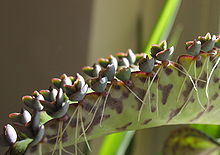Adventitious formation

Adventive formations ( lat. Adventus 'added') denote parts of a plant that do not arise from an apical ( stem axis ) or a basal ( root ) primary meristem , but from tissues of a plant that have become secondarily capable of dividing and growing again (“remeristematised”) like residual meristems or callus tissue on a wound site. The plant is often preceded by an injury, or they are formed when fresh shoots are partially or completely frozen off by a cold snap in spring. A distinction is made between the following adventitious formations:
- Adventitious buds are buds that are not formed at the tips of the shoots or in leaf axils like regular buds , but at other points on the axis on leaves or roots. They are sometimes formed spontaneously in old parts of the plant and more often after the plant has been damaged. Examples are brood buds on brood leaves (in leaf notches) or meadow foam herb (underside of the leaf)
- Adventitious shoots on cut begonia leaves , as stick rashes

- Adventitious roots , also called sprout roots, arise in monocotyledons (monocotyledons) when germinating seeds from a primary root , whose function they take over. Over time, the adventitious roots branch out very strongly and form a complex, bushy root system. No main root axis can be seen. In contrast to this, dicotyledons develop a taproot, which is the main root axis. Side roots emanate from it. Adventitious roots can also be formed as a result of injuries or treatment of growth substances. The black alder develops adventitious roots in order to react to the fluctuating water levels in its biotope (alder forest) (see also common bald cypress ).
- A special case is the Adventivembryonie . This is the adventitious formation of embryos from vegetative cells of the ovule; this occurs especially with citrus plants . It creates many embryos in seeds.
- An adventitious shoot is a bud that is newly formed in the same year (plant already there), which also sprouts immediately in the year of education, for the purpose of support in the event of injury or exploitation of good conditions.
- A preventive shoot is a bud that has been dormant for years , is formed as a precaution and sprouts when the tree is damaged or in particularly good conditions.
Phytohormones and here in particular hormones from the group of auxins can initiate and promote adventitious formation. This is done within the framework of in vitro -Culture and in Stecklingsbewurzlung in horticultural production to Use.
Images of adventitious roots
swell
- Andreas Bresinsky , Christian Körner , Joachim W. Kadereit , Gunther Neuhaus , Uwe Sonnewald : Strasburger - textbook of botany. Founded by E. Strasburger. Spektrum Akademischer Verlag, Heidelberg 2008 (36th edition) ISBN 978-3827414557
- Herder-Lexicon of Biology, Spectrum Academ. Verlag, 1994, Vol. 1, p. 54. ISBN 3-86025-156-2

